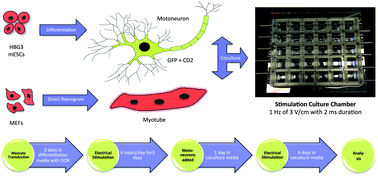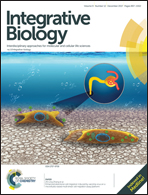Bioreactor model of neuromuscular junction with electrical stimulation for pharmacological potency testing†
Abstract
In vitro models of the neuromuscular junction (NMJ) are emerging as a valuable tool to study synaptogenesis, synaptic maintenance, and pathogenesis of neurodegenerative diseases. Many models have previously been developed using a variety of cell sources for skeletal muscle and motoneurons. These models can advanced by integrating beneficial features of the native developmental milieu of the NMJ. We created a functional in vitro model of NMJ by bioreactor cultivation of transdifferentiated myocytes and stem cell-derived motoneurons, in the presence of electrical stimulation. In conjunction with a coculture medium, electrical stimulation resulted in improved maturation and function of motoneurons and myocytes, as evidenced by mature cellular structures, increased expression of neuronal and muscular genes, clusterization of acetylcholine receptors (AChRs) in the vicinity of motoneurons, and the response to glutamate stimulation. To validate the model and demonstrate its utility for pharmacological testing, we documented the potency of drugs that affect key pathways during NMJ signal transduction: (i) acetylcholine (ACh) synthesis, (ii) ACh vesicular storage, (iii) ACh synaptic release, (iv) AChR activation, and (v) ACh inactivation in the synaptic cleft. The model properly responded to the drugs in a concentration-dependent manner. We thus propose that this in vitro model of NMJ could be used as a platform in pharmacological screening and controlled studies of neuromuscular diseases.



 Please wait while we load your content...
Please wait while we load your content...